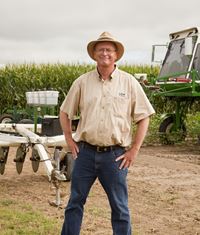|
Prescription Management
Research Applied On-Farm Helps Farmers Boost Production
BETTY VALLE GEGG-NAEGER
MidAmerica Farmer Grower
ST. JOSEPH, LA.
Dennis Burns, county agent in Tensas Parish and one of the precision ag agents for the LSU Ag center, explained some of the ongoing efforts underway at the Northeast Research Station and how it can help farmers micro-manage.

Working on mid-season nitrogen applications using crop sensors is Dennis Burns, county agent in Tensas Parish and one of the precision ag agents for LSU Ag Center and explained how it can help farmers micro-manage.
Photo by John LaRose, Jr.
“We do a lot of on-farm demonstrations, we take the research that the scientists produce here on the station and we move it to production farms,” he said. “So today we’re having demonstrations for our field day. We’ve set up a crop rotation and a mid-season sensor nitrogen application. We do a lot of on-farm work with mid-season nitrogen applications using crop sensors, using NDVI (Normalized Difference Vegetation Index). We’re setting this up so the farmer can come and look at a basic standard nitrogen rate on corn or cotton and a mid-season nitrogen rate and he can visually see it. We have solid 200-foot rows here so a farmer can see how it varies through the field and we’re also bringing the crop rotation up.”
The three main crops here are cotton, corn and soybeans and usually the rotation is cotton and corn back to back or corn and soybeans back to back. This will be set up for the next few years. “Our stop was to show the rotation behind the different crops, comparing a full season application versus a mid-season nitrogen application using the sensors,” he said.
“You can look at the corn over here and you just really don’t see a lot of difference,” Burns said. “The cotton has had only the initial sidedress put out and there’s virtually no difference in it. We’ll collect yield data just to determine how well we did at the end of the year, because the real score card is yield and what contributes to it. This was set up along the road so people can stop, they can look at it, we’ll put some signs out a little bit later so when people ride by they’ll see it and know where we’re going with this.”
Some of the equipment for the on-farm research was on display for farmers to see. One item was a high clearance sprayer which has crop sensors and a spray boom attached so variable rate applications for fertilizer, PGRs, (Plant Growth Regulators) or anything liquid can be applied variable rate. There’s a Veris Ec cart which can be used to determine soil zones and develop soil sampling plans. The zone sampling is to help farmers prepare prescriptions for different fertilizer application rates.
“Something new we’re working on now is a granular applicator,” he said. “We’ll be able to do variable rate granular applications this fall. This is an old 4-row rig that we had and we’re adding two more units to make it a 6-row, then we’ll set it up so we can haul it to the farm, hook it to a farmer’s tractor and let him put out variable rate applications.
“This year as we worked with farmers, instead of us taking our equipment and putting out the applications for them, we’re trying to incorporate what we’re doing into their precision ag equipment, and we’ve had some really good success with that. We’re especially happy when a farmer comes and says ‘this is great’. One cooperating producer had never used a prescription before, we loaded it into his machine, and he was actually able to apply it. He had an auto steer tractor and all he did was turn around on the end. He came to me later that day and said ‘we’re going to do this everywhere next year.’ He said ‘this is great. This is the best thing ever.’
“That’s what we’re looking for, that light bulb moment that goes off when a farmer realizes the value of the prescription and how it can benefit him. That’s what we hope to attain with our on-farm projects.”∆
BETTY VALLE GEGG-NAEGER: Senior Staff Writer, MidAmerica Farmer Grower
|
|